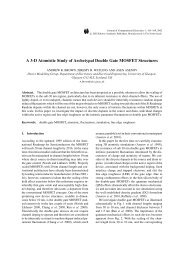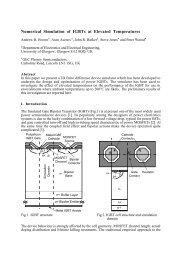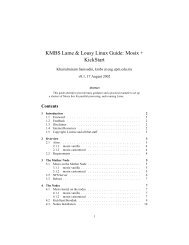Diffusione Raman Anelastica Risonante di Raggi X con Risoluzione ...
Diffusione Raman Anelastica Risonante di Raggi X con Risoluzione ...
Diffusione Raman Anelastica Risonante di Raggi X con Risoluzione ...
Create successful ePaper yourself
Turn your PDF publications into a flip-book with our unique Google optimized e-Paper software.
24 <strong>Diffusione</strong> <strong>Raman</strong> <strong>Anelastica</strong> <strong>Risonante</strong> <strong>di</strong> <strong>Raggi</strong> X <strong>con</strong> <strong>Risoluzione</strong> Angolare<br />
Quin<strong>di</strong> la matrice Tfi risulta:<br />
¿<br />
Tfi =<br />
¯<br />
Ψf ¯Hd 1<br />
1<br />
Ei − H + iη Hd ¯<br />
1¯<br />
Ψi<br />
À<br />
Per riuscire a calcolare questo elemento <strong>di</strong> matrice si deve utilizzare un modello del fenomeno<br />
introdotto da Ugo Fano (Rif.[26]) e succesivamente ripreso nel Rif.[4]. Lo stato interme<strong>di</strong>o<br />
del sistema è lo stato |b, 0i che corrisponde allo stato in cui l’atomo si trova<br />
nello stato eccitato |ψbi e l’unico fotone presente inizialmente nel sistema è stato assorbito,<br />
quin<strong>di</strong> in assenza <strong>di</strong> quanti del campo elettromagnetico. Gli stati |Ψii, |Ψfi, e|b, 0i<br />
sono tutti autostati dell’hamiltoniano imperturbato H0: glistati|Ψiie |Ψfi sono stati che<br />
appartengono ad un <strong>con</strong>tinuo, invece |b, 0i è uno stato <strong>di</strong>screto. Il processo viene quin<strong>di</strong> descritto<br />
come la transizione tra due stati che appartengono ad un <strong>con</strong>tinuo, <strong>con</strong> il passaggio<br />
del sistema attraverso uno stato <strong>di</strong>screto.<br />
Per poter affrontare il problema si devono <strong>di</strong>scretizzare gli stati <strong>con</strong>tinui, <strong>con</strong> una tecnica<br />
analoga a quella usata per il campo eletromagnetico. Gli stati |Ψαi del <strong>con</strong>tinuo sono<br />
sostituiti <strong>con</strong> gli stati <strong>di</strong>screti |ki che hanno energie <strong>di</strong>stanti per un parametro δ. Ladensità<br />
degli stati è quin<strong>di</strong> 1/δ. I risultati fisici si ottengono facendo il limite per δ → 0. Si<br />
definisce l’elemento <strong>di</strong> matrice:<br />
hk |V | b, 0i = v<br />
Si è supposto che il valore <strong>di</strong> questo elemento <strong>di</strong> matrice sia in<strong>di</strong>pendente da |ki. L’applicazione<br />
della regola d’oro <strong>di</strong> Fermi per un sistema inizialmente nello stato |b, 0i porta ad una probabilità<br />
<strong>di</strong> transizione per unità <strong>di</strong> tempo verso il <strong>con</strong>tinuo data da:<br />
Γb = 2π<br />
~δ v2<br />
(2.9)<br />
Avendo calcolato questa probabilità <strong>con</strong> la regola d’oro <strong>di</strong> Fermi non generalizzata, questo<br />
è un effetto al se<strong>con</strong>do or<strong>di</strong>ne nell’hamiltoniano d’interazione.<br />
Supponendo che il <strong>con</strong>tinuo <strong>di</strong>scretizzato si estenda da −∞ a +∞ <strong>con</strong> i livelli equi<strong>di</strong>stanti<br />
separati dalla quantità δ,siha:<br />
H0 |ki = Ek |ki = kδ |ki<br />
Dove k appartiene ai numeri interi relativi (∈ I). Allo stesso modo, si può scrivere per il<br />
livello <strong>di</strong>screto:<br />
H0 |b, 0i = Eb |b, 0i<br />
Si suppone inoltre che, a parte l’elemento <strong>di</strong> matrice hk |V | b, 0i, tutti gli altri sono nulli:<br />
hb, 0 |V | b, 0i = hk |V | k 0 i =0<br />
Si <strong>con</strong>siderano ora gli autostati |µi dell’hamiltoniano totale H = H0 + V :<br />
H|µi = Eµ |µi





